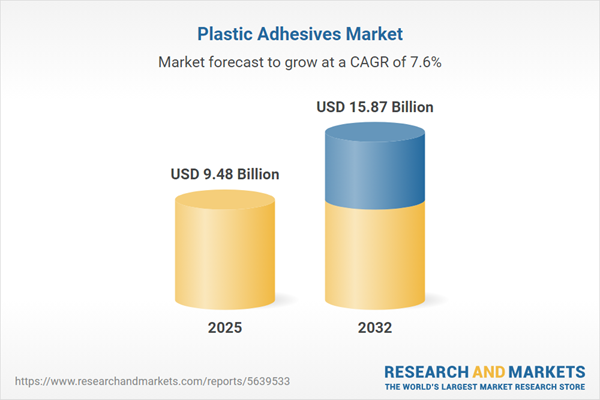Speak directly to the analyst to clarify any post sales queries you may have.
The plastic adhesives market is evolving quickly as manufacturers in sectors like automotive, electronics, and healthcare demand enhanced performance, sustainability, and procurement resilience from adhesive systems. Innovation in chemistries and end-use applications is promoting a decisive industry shift toward greener, higher-value solutions that serve a wide spectrum of industrial needs.
Market Snapshot: Plastic Adhesives Market Growth & Opportunity
The Plastic Adhesives Market grew from USD 8.82 billion in 2024 to USD 9.48 billion in 2025. It is expected to continue growing at a CAGR of 7.61%, reaching USD 15.87 billion by 2032. This advancement reflects significant momentum from increased end-user demand, regulatory action promoting low-emission products, and global connectivity stimulating technology adoption throughout value chains. The market’s upward trajectory signals robust expansion driven by customer trends and manufacturing priorities.
Scope & Segmentation of the Plastic Adhesives Market
- Technology: Includes hot melt such as ethylene vinyl acetate, polyamide, polyolefin, and polyurethane; reactive types like acrylic, cyanoacrylate, epoxy, polyurethane, and silicone; as well as solvent based, UV cure, and water based formulations.
- Application: Spans automotive and transportation (exterior, interior, powertrain, structural bonding), construction (facade, flooring, roofing, tiling), consumer goods (appliances, footwear, sports equipment, toys), electronics (component mounting, display bonding, encapsulation, PCB assembly), medical and healthcare (device assembly, dressings, wound closure), packaging (corrugated carton, flexible packaging, folding cartons, labels and tapes), and woodworking (cabinetry, flooring, frame building, furniture).
- End Use Industry: Automotive and transportation, construction, consumer goods, electronics and electrical, medical and healthcare, woodworking and furniture.
- Form: Film, granules, liquid, paste.
- Packaging: Corrugated carton, flexible packaging, folding cartons, labels and tapes.
- Regional Coverage: Americas (United States, Canada, Mexico, Brazil, Argentina, Chile, Colombia, Peru), Europe, Middle East & Africa (United Kingdom, Germany, France, Russia, Italy, Spain, Netherlands, Sweden, Poland, Switzerland, United Arab Emirates, Saudi Arabia, Qatar, Turkey, Israel, South Africa, Nigeria, Egypt, Kenya), Asia-Pacific (China, India, Japan, Australia, South Korea, Indonesia, Thailand, Malaysia, Singapore, Taiwan).
- Company Coverage: Analyzes recent developments across leading players such as Henkel AG & Co. KGaA, 3M Company, Sika AG, H.B. Fuller Company, Arkema S.A., Dow Inc., RPM International Inc., Ashland Global Holdings Inc., Huntsman Corporation, Evonik Industries AG.
Key Takeaways for Senior Decision-Makers
- Technology advances in polymer science and digitalization are expanding the range of adhesive solutions and their precision, especially as electronics miniaturization and additive manufacturing drive new technical requirements.
- Environmental pressures and evolving regulations are making water based and UV cure adhesives increasingly prominent, allowing manufacturers to meet sustainability targets and address growing demand for low-emission products.
- Strategic partnerships and co-development initiatives between chemical suppliers and manufacturers foster tailored innovation, accelerate commercialization cycles, and reinforce supply chain resilience.
- Hot melt and reactive chemistries are becoming preferred for high-volume and demanding structural applications, supporting market versatility and customer specification flexibility.
- Collaborative initiatives across the value chain—particularly in automotive, medical, and packaging sectors—strengthen long-term risk management, cost optimization, and delivery of engineered adhesive solutions.
Tariff Impact: Adjustments and Resilience in a Changing Trade Landscape
In 2025, new tariffs on imported resin precursors and intermediate chemicals have required adhesive producers to revamp sourcing and develop alternative formulations. These policy moves have encouraged regional sourcing, backward integration, and new supplier relationships that help stabilize costs and ensure continuity despite short-term disruption. These adaptations also promote renewed innovation and strategic supply realignment, especially for companies serving cost-sensitive markets.
Methodology & Data Sources
This report employs a rigorous approach, combining primary interviews with industry experts, reviews of technical literature and trade publications, and detailed validation of company disclosures and government statistics. Both top-down and bottom-up analyses are used to capture macroeconomic drivers and operational nuances, and all insights were peer reviewed to confirm accuracy and methodological soundness.
Why This Report Matters
- Equips industry leaders with actionable intelligence for investment planning, procurement, and technology development in the rapidly evolving adhesives market.
- Enables executives to anticipate market shifts, regulatory challenges, and supply chain vulnerabilities, supporting resilient business strategies.
- Delivers a mapped view of segment-specific opportunities and innovation pathways for maintaining competitive advantage across diverse regional landscapes.
Conclusion
By applying the insights from this comprehensive report, stakeholders can proactively navigate the plastic adhesives sector’s dynamic environment, make informed strategic decisions, and capitalize on emerging opportunities with confidence.
Additional Product Information:
- Purchase of this report includes 1 year online access with quarterly updates.
- This report can be updated on request. Please contact our Customer Experience team using the Ask a Question widget on our website.
Table of Contents
3. Executive Summary
4. Market Overview
7. Cumulative Impact of Artificial Intelligence 2025
Companies Mentioned
The companies profiled in this Plastic Adhesives market report include:- Henkel AG & Co. KGaA
- 3M Company
- Sika AG
- H.B. Fuller Company
- Arkema S.A.
- Dow Inc.
- RPM International Inc.
- Ashland Global Holdings Inc.
- Huntsman Corporation
- Evonik Industries AG
Table Information
| Report Attribute | Details |
|---|---|
| No. of Pages | 182 |
| Published | October 2025 |
| Forecast Period | 2025 - 2032 |
| Estimated Market Value ( USD | $ 9.48 Billion |
| Forecasted Market Value ( USD | $ 15.87 Billion |
| Compound Annual Growth Rate | 7.6% |
| Regions Covered | Global |
| No. of Companies Mentioned | 11 |









